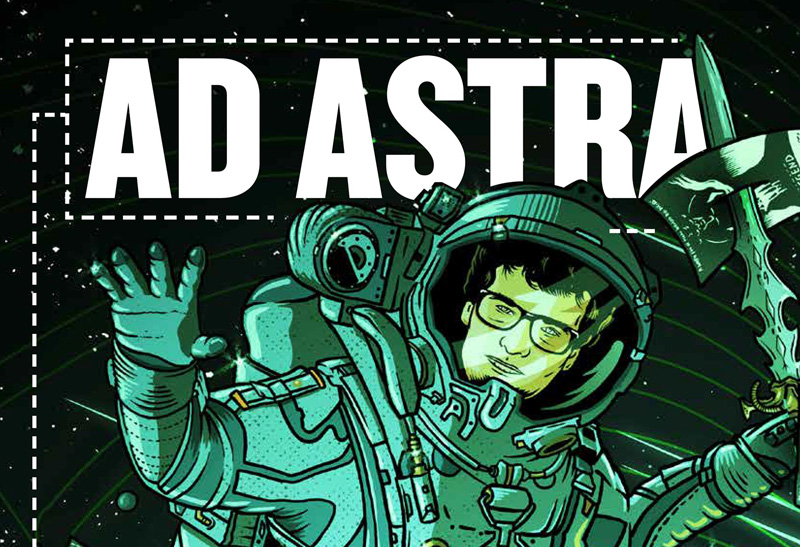During this past summer’s Fantasia Film Festival in Montreal, ComingSoon.net sat down with former Fangoria editor and horror maven Michael Gingold to chat about his new book Ad Astra, which collects newspaper ads for sci-fi films from the 80’s through the 2000s. Check out the interview below, and click here to purchase Ad Astra today!
RELATED: CS Interview: Michael Gingold on 80’s Horror Book Ad Nauseam
Once upon a time – the 1980s – in a galaxy not really all that far away – New York – Michael Gingold started a collection of newspaper advertisements for the science fiction, fantasy and horror releases that stoked his passion as a genre fan. Eventually, he would grow up to become a contributor, then editor, and even editor-in-chief of the legendary horror magazine Fangoria, plus a writer for numerous other genre publications, a screenwriter, respected author and all around expert for films frightful and fanstastical. As the years went by, Michael held on to this collection of weird and wonderful art, eventually publishing the best-selling, horror-themed Ad Nauseam: Newsprint Nightmares from the 1980s and its sequel, Newsprint Nightmares from the 1990s and 2000s. And now he presents Ad Astra: 20 Years of Newspaper Ads for Sci-Fi & Fantasy Films, a year-by-year look at the movies that shaped many a childhood in the 80s and 90s.
Inside this 270-page book, you’ll find Star Trek to Starship Troopers, The Dark Crystal to Dark City, Blade Runner to The Running Man, RoboCop to Robot Jox, The Empire Strikes Back to Back to the Future, and many, many more. See alternate artwork for your favorite films, learn the fascinating behind-the-scenes stories of their marketing campaigns, and read the most entertaining and unexpected quotes from reviewers at the time all carefully curated by Michael.
RELATED: Michael Gingold Talks Frightfest’s Guide to Monster Movies
ComingSoon.net: Let’s talk just for a minute about the success of the first book, “Ad Nauseam.” You got a lot of notice for that. You had some celebs give you plugs. Can you talk about the experience putting that book out?
Michael Gingold: Yeah, it was great because it was something that I’d wanted to do for 20 years, and it was really great to see that there was in fact an audience for it. And especially when I would do signings and events in the New York area, the reaction that I got from a lot of people was not so much the ads themselves, but seeing all the theaters and the listings on the bottom because everyone had a story about this or that theater that they grew up near that they would go see these movies back at the time. Not even these films necessarily. If they grew up a little later, maybe they went there in the 90s. But it really brought home for them memories of the theatergoing experience because most of the theaters that you’ll see in those listings no longer exist. This was the pre-multiplex era, and then the multiplexes came in. And even in Times Square, and I’m not talking the 42nd Street grindhouses, I’m talking the major theaters that used to be in Times Square. None of those are left because you have the two huge multiplexes down the end of 42nd that basically took away their business.
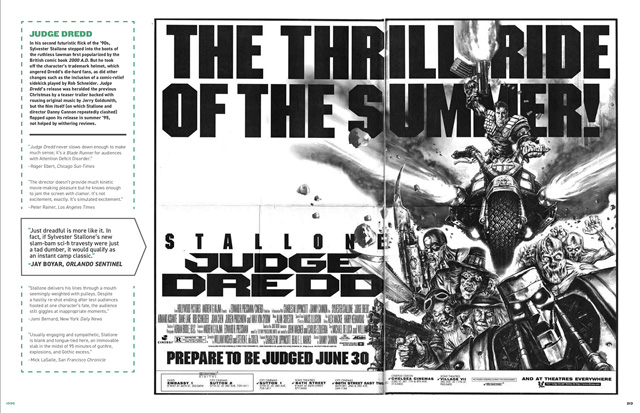
CS: I was surprised to see just how many regional theaters certain films were in. “Spookies” was in seven theaters.
Gingold: Yeah, well, there was a certain time where it’s weird how it worked because video came in and obviously impacted the theatrical business tremendously. However, and I remember seeing in the video trade magazines at the time, every little low budget direct to video movie had a little banner saying, “Direct from theatrical release.” So I think there was a certain contractual element, or maybe just a loss leader thing, where a lot of stuff that went “direct to video” did play a few theaters somewhere, not always New York, because New York is an expensive place to open something. But certainly, the New York based distributors. I believe the distributor for “Lady Terminator” was New York based. So it was probably just easier for them. And it played 26 theaters in the New York area, believe it or not, which even for that time it was kind of strange to see a movie that low rent and cheesy playing that many theaters in that area.
CS: It’s similar today with the VOD, where they’ll do the token theatrical so that they can say that it’s in theaters and on VOD.
Gingold: Yeah, they always want to say day and date theaters and VOD, and then every so often they send the list and the theater is in Cleveland and Atlanta. Not anything against those cities, but they’re not the major markets, because again, it costs more to open in New York and LA.
CS: And it’s not as cost heavy anymore because you don’t have to make prints. You would just send the DCP out.
Gingold: Well, there are some theaters in New York where they would just show Blu-rays.
CS: But not in the 80s.
Gingold: No, in the 80s it was entirely different. You’d still have to make those 26 prints or however many of them. But again, you know, it was like that for decades. They’d make that finite number of prints and then they’d ship them from city to city. There were just fewer of them as the 80s went on. Then, in the 90s -and you’ll see this, especially if you look at “Ad Nauseam II”- there are fewer and fewer theatrical releases. There’s one year in the 90s in “Ad Nauseam II” where there are only nine theatrically released horror films. So it really went into a slump. Of course “Scream” and then later “Blair Witch Project” and “Sixth Sense” just jumpstarted everything. And then you got into the 2000s, where the interesting thing was that suddenly independent horror films were being treated like art films. The example I site in the book is “Cemetery Man”, which was an Italian zombie film. In the 80s a company like MPM or something would probably put that out as a drive-in and grindhouse feature. But October Films treated it like an art film. They opened it in a few theaters in different cities on kind of the art film circuit.
CS: They platformed it.
Gingold: Yeah. And it was a real change in the way independent horror was released theatrically. So in the 2000s, suddenly there’s this proliferation. You know, right now, we’re finalizing the layout for “Ad Nauseum II” and it’s hard to cram in everything because there are three dozen titles a year, all of them really small films, but they all got some sort of theatrical release in the New York area. I think the other reason for that is that theatrical films get reviews and direct to video films do not, at least not from the newspapers and a lot of other outlets. So it was a way to get critical notice, which became more important in the 2000s, because critics actually started taking horror films seriously and giving them more positive reviews than they had in the 80s. The genre kind of got a new legitimacy at that point.
CS: Getting back to the books, “Ad Astra” has a forward by “Ed Wood” screenwriter Larry Karaszewski.
Gingold: That was simply because he was talking about “Ad Nauseam” on Facebook. And I friended him and he went through—I think he said he had someone he knows go back in his hometown archives…
CS: He had a relative.
Gingold: Yeah, one of his relatives just went through microfiche and microfilm and got duplicates of all of these ads. And he was running them on his Facebook page on a weekly basis.
CS: Double bills. The double bills that he was fascinated with. Like what was paired with what.
Gingold: So we knew he wanted someone in the genre to do a forward for us, and I figured not only are a couple of his movies represented, but also he is a huge collector of ads as well. He goes back even further than I do, so he was kind of a perfect guy to do the forward and he wrote a really nice little piece for the beginning of the book.
CS: Yeah, and Larry and Scott have done a couple of horror projects. They did “1408”. They did “Goosebumps”.
Gingold: For the fantasy one, they did “Ed Wood” obviously. I think they’re uncredited on “Mars Attacks” and a couple of other things. But he’s kind of into the history of this the way I am, so the one thing he cited, which I thought was great, was going to see “Dune” and getting the terminology sheet handed to you to explain who and what everything was, like a double-sided page with like, “here are all the people and places and things you need to know to understand what’s going on in this film.” And we duly duplicate those in the book as well.
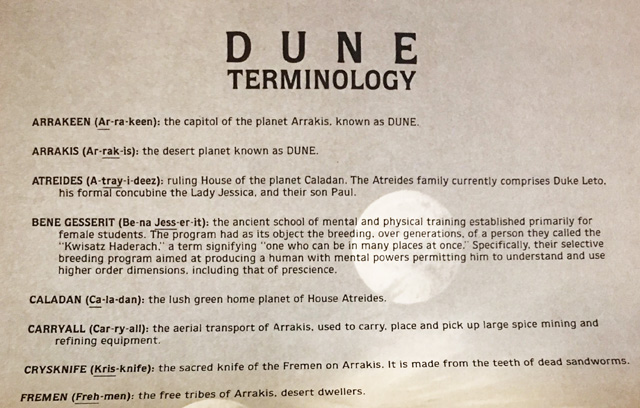
CS: That was actually one of the movies I wanted to start getting into a little bit because “Dune” is a really interesting film to watch now. It’s the only film that Lynch ever did that is him working on a large canvas. It is fascinating to see what was at the time a $40 million movie, which would today be like $100 and something million.
Gingold: Yeah, it was a huge budget for its time.
CS: A huge budget, one of the most expensive films ever made, yet it is so bizarre. It is so outlandishly weird. Some of that is Lynch adding in his craziness, and then some of it is just the act of trying to condense a really complex Shakespearean plot into two hours and 20 minutes with all of this crazy terminology, like you said. What do you recall being the reaction to the film at the time and have you reassessed it in the years since?
Gingold: Well, I just remembered some of the reviews were absolutely terrible for it. I mean, it was kind of a sophomore slump, even though it was his third film because he’d obviously done “Eraserhead”, but that was really underground, and then he did “Elephant Man”, which was his first mainstream film. A successful film and Oscar winning. “Dune” was the next big step up.
CS: There was this period, this brief window where because of the success of “The Elephant Man” people thought, “Oh, here’s a filmmaker who could be the next George Lucas.” And they could not have been more wrong.
Gingold: Well, yeah. There were all these problems I know behind the scenes and getting it into a releasable shape. This was a movie they advertised very early. It came out in December and I remember there was a trailer for it attached to “The Last Starfighter”, which came out the summer before. So it was one of the earliest cases of a movie trailering that early before the movie was coming out.
CS: Because they thought this could be a huge franchise with toys and stuff.
Gingold: Yeah, it was going to be huge, yeah. It was Universal’s big release for that winter.
CS: And he was actually writing the script for “Dune: Messiah” before it came out. He was full into this universe.
Gingold: “Dune” also came out on December 14, 1984, opposite two other major sci-fi films. It opened opposite “Starman”, John Carpenter’s film, and “Runaway” with Tom Selleck. So that was a big sci-fi day in December.
CS: Why would they cluster all three of those movies together?
Gingold: Well, back at the time, Christmas was a huge thing. It was bigger than it is now. I think in ’83, the December before there was one day when seven major studio films all opened the same day. It was a bloodbath. But Christmas was considered the way summer is now. It was a huge time to open movies, and I guess they all thought they had the goods. I mean, they’re slightly different. “Dune” is this big kind of weird epic, “Starman” is a much more intimate science fiction drama. And then “Runaway” is like a hardcore action thing. Nobody wanted to blink. I think with “Dune”, Universal probably thought, “Well, we’ve got this huge, well-known property and we’ve got this hot director. We’re going to come out on top.” And then none of them did especially well. I think “Starman”, by default, was kind of the most successful of them because it was not as expensive and did a decent amount of business.
CS: Right. Is it a film that you’ve revisited at all or reassessed in years?
Gingold: I saw it again a while back. It still doesn’t work, but I can kind of see the flashes of brilliance in it. There’s a lot of films like that from the 80s that are very problematic, but you can see what the director was trying for and what they partially accomplished amidst the whole wreck of what’s on screen. But I think there’s a quote from a review I used in the book that sums it up. It’s like, “Imagine if every other page of ‘Dune’ the book had been torn out and replaced with a pretty picture.” And that’s the experience of watching the film because it’s got all this great imagery, but the story is just so haphazard, the way it wound up on screen.
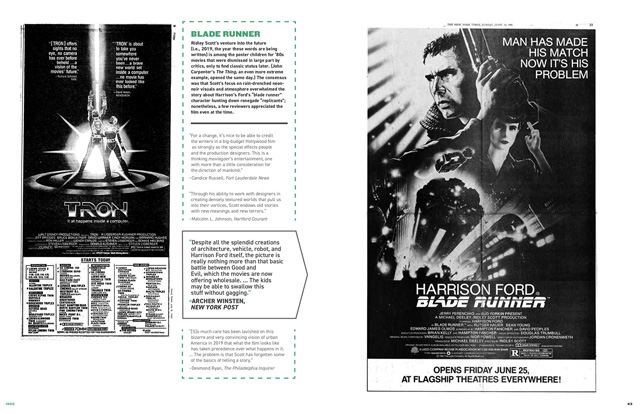
CS: Another sci-fi film that got famously retooled and recut is “Blade Runner”.
Gingold: Yeah, well that’s not quite as severe as the other ones. And I get the feeling some of that is Ridley Scott seeing things later that he wants to go back and fix.
CS: Ridley Scott has always been much more amenable to working with a studio to “fix” his movies upon theatrical release. Then he’ll go back and he’ll do it proper for the video.
Gingold: Yeah.
CS: It happened in “Kingdom of Heaven”. It happened with “Blade Runner”. It happened with “Legend”. But in terms of “Blade Runner” you’ve got the star of “Star Wars” and “Raiders of the Lost Ark”. You’ve got the director of “Alien”. You’ve got Philip K. Dick, who is not what he is today, but at the time, was still a well known sci-fi writer. So you’ve got these three elements all coming together in this big event science fiction movie, and it just lands with a fucking thud.
Gingold: Well, I mean, that was another case. That opened the same day as “The Thing”. And “The Thing” did even worse. I mean “Blade Runner” did okay. That was the summer that was dominated by “E.T.” and “Poltergeist”.
CS: And “Star Trek 2”.
Gingold: Yeah, “Star Trek”, even “Firefox”, the Clint Eastwood movie, which is a bit sci-fi because it’s on the high tech plane and John Dykstra doing effects on it.
CS: Some cool effects in it.
Gingold: A lot of the “Blade Runner” reviews were saying this is just style over substance, and the reviews were not terribly favorable. To be honest, I think “Blade Runner” is a very flawed film also, at least in that theatrical cut. So when I finally saw it, I could kind of see what the critics were saying. The reviews were not nearly as terrible as they were for “The Thing”, when were just dreadful in a lot of cases.
CS: But was it a film that stayed with you or was it just one of these films that sort of came and went and you forgot about?
Gingold: Well, it’s funny. I went off to summer camp the day after those two movies opened, and I was very upset that my parents would not let me go see “The Thing” with a couple of my friends the night before, because I had to be rested for my big day the next day. But you know, this was back at the time when movies would play for the entire summer. “Rocky III” came out Memorial Day ’82. I wound up seeing it with my family Labor Day 1982, and the theater was still completely packed. So I went off to summer camp thinking, well, of course “The Thing” will still be playing when I get home, and “Blade Runner”. And “The Thing” was gone. It was in one theater in Manhattan by that point, and “Blade Runner” was almost out of the picture as well, because they had both bombed in the case of “The Thing” and disappointed in the case of “Blade Runner” so spectacularly that they were not in many theaters by that point. But “E.T.” played for… I think its first run was literally a year. I mean, if you look, there are certain ads in the book where you see things like “Empire Strikes Back” was “re-released” a year later, but in some places, it had never gone away. “E.T.” was reissued in ’85. You know, this was back before video really took over, there was a theatrical shelf life for these films. And in fact, I think in October ’82 “The Thing” and “Conan” were rereleased on a double bill. They would get as much theatrical life out of movies as possible, which was, again, something that you see in the 80s and not so much as you get into the 90s.
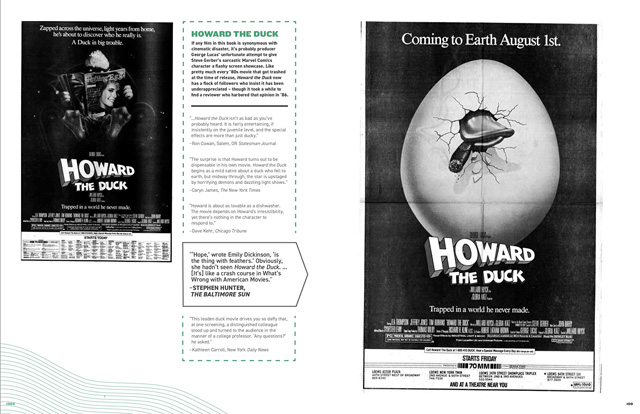
CS: “Conan’s” an interesting movie for right now, because it made a lot of money, but it was so ahead of its time in the sense that there wasn’t really another big budget A-grade studio R-rated fantasy movie at that level until you get to “Game of Thrones”.
Gingold: It spawned tons and tons of them. That’s one trend you can see in the book is all the sword and sorcery stuff.
CS: Yeah, you had the “Sword and the Sorcerer”. You have “The Beastmaster”. You have all those types of things. But all those were lower budget B-movies. And even the sequel to “Conan”, “Conan the Destroyer”, they tried to giddy it up, they tried to PG-13 it. And it didn’t work.
Gingold: I actually like “Conan the Destroyer”.
CS: You like “Conan the Destroyer”?
Gingold: It has the greatest cast in film history, I think. It’s got such a weird cast. Andre the Giant, Wilt Chamberlain, Grace Jones, Mako, Tracey Walter, Olivia d’Abo, just weird mix and match cast. But yeah, that’s one of the other fun things in the book is seeing the movies that sparked these trends. Like you can see all the “Road Warrior” rip-offs that came out. And there were so many of those, and the “Conan” rip-offs and things like that. You had sword in the title “Sword and the Sorcerer” and “Sword of the Barbarians”, and then you have “Sorceress,” which has a sword through the S. And the taglines are all the same. It’s like, “Journey to a land of wonder and fantasy.” You’ll see a lot of very similar taglines throughout the book for all of these things.
CS: What were some sci-fi movies that you dug up that are not necessarily celebrated today, but you’re like, oh, I remember that, that’s actually a good one, but nobody talks about it?
Gingold: “Buckaroo Bonzai” is one.
CS: I just re-watched “Buckaroo” recently. When I watch that movie through contemporary eyes, I think it is remarkably weird. It almost has the feel of a Robert Altman movie from the 70’s, in the sense that you’ve got all these numerous whacky characters in an ensemble. The plot does not make a lot of sense. And if you’re really assessing it properly, I would say it’s a movie that has about 30 minutes of brilliance, and then another hour of “What the fuck?”
Gingold: I don’t know. I think there’s more brilliance to it than that. That was fun, because they actually released that regionally. It didn’t even get a nationwide release because I had a friend who saw it in LA, I think a couple of months before it finally made it to New York, and that’s another case where they actually have in the ads like “Six things you need to know before you see ‘Buckaroo Bonzai’” and this was the same year as “Dune”, so that was the big year for like, movies where they needed to explain to the audience in advance what happens in them.
